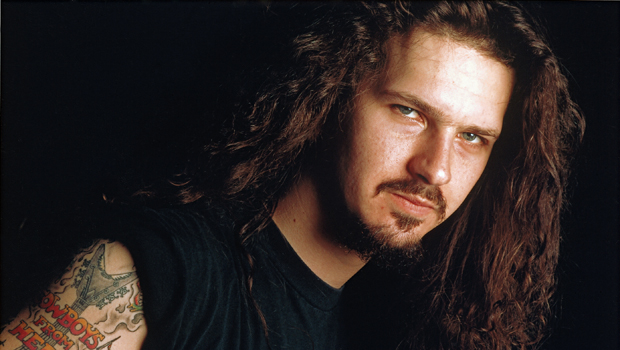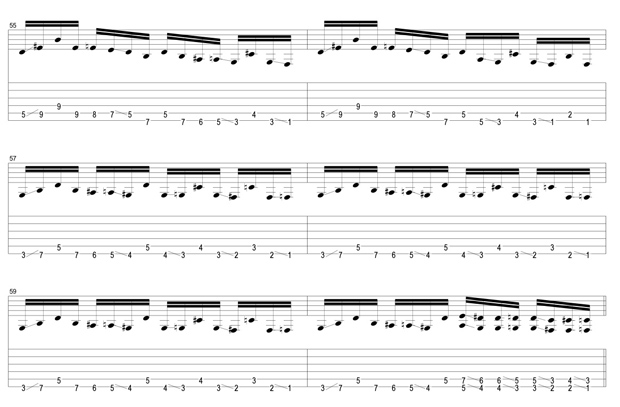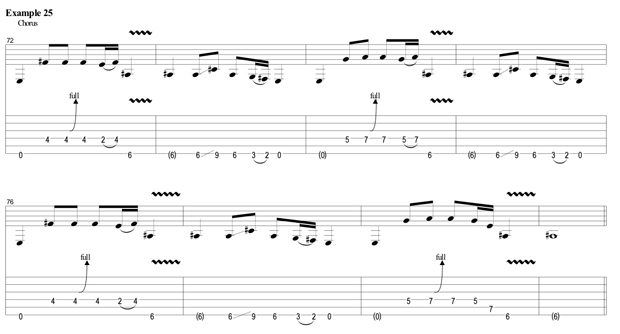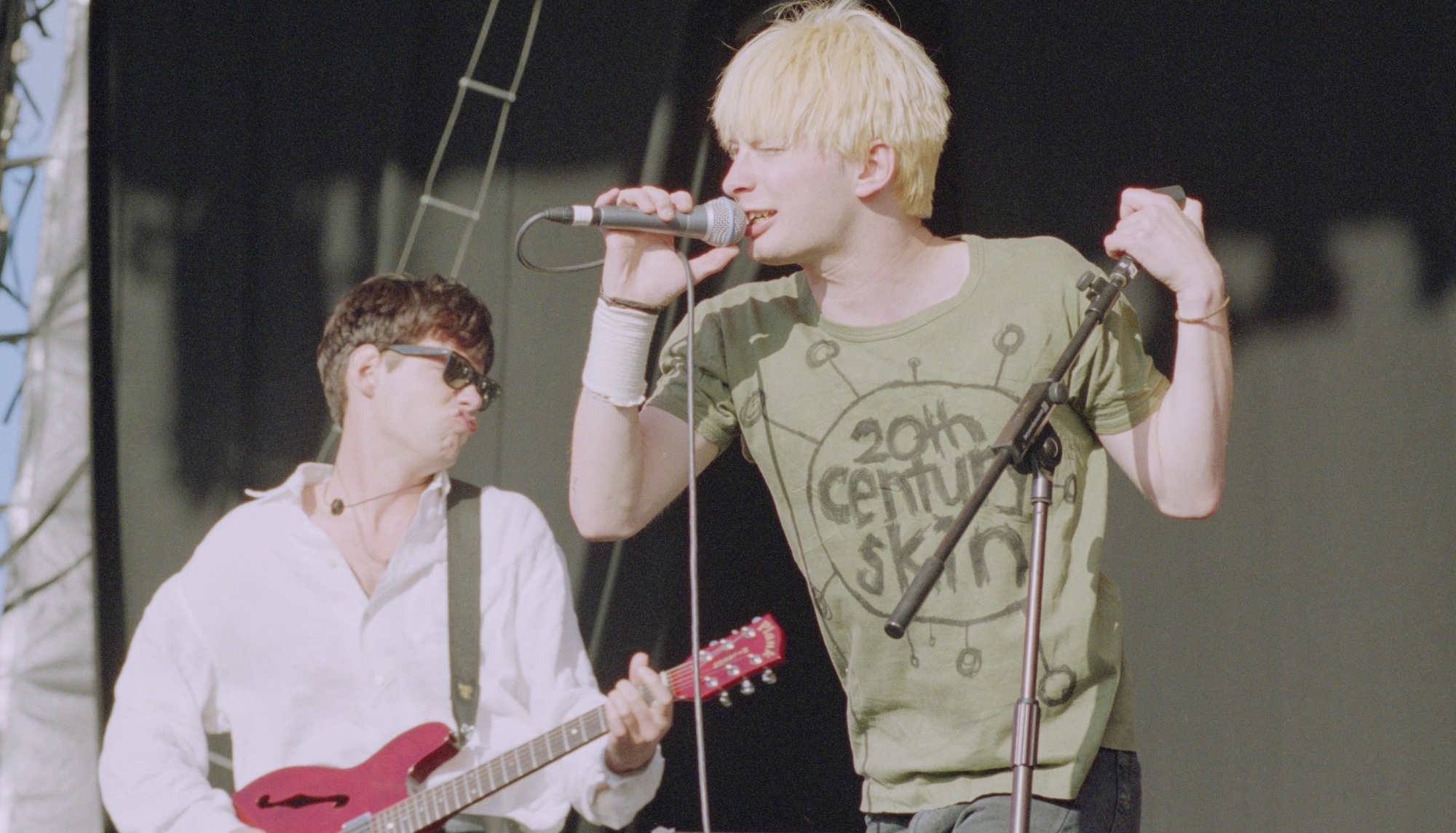Guitar Strength: 10 Commandments of Playing Guitar in the Style of Dimebag Darrell, Part 2

Hello, everyone. Here's part two of my Guitar Strength blog, "10 Commandments of Playing Guitar in the Style of Dimebag Darrell." Be sure to check out part one right here.
Commandment 6: Change Your “Tune”
One of the things most unique to Dimebag throughout his career was his use of altered tunings. From Cowboys From Hell to Reinventing the Steel, Dime constantly challenged the preconceptions of how a guitar should be tuned. Early on, when tuned “regularly” to E (E, A, D, G, B, E), Dime’s guitars were actually tuned down more than a quarter step. As his guitar tech has noted, that meant that the guitars were tuned to “D# plus 40 cents on his Korg tuner. The A string was G# plus 40 cents, D was C# plus 40 cents, etc.” (Note: The Van Halen influence is definitely in effect here, as Van Halen I and Van Halen II are tuned in a similar manner.)
Dimebag also experimented with “drop D” tuning on Cowboys From Hell (C# plus 40 cents), but later become a fan of tuning the entire guitar down a whole step, beginning with A Vulgar Display of Power. This tuning (D,G,C,F,A,D-a quarter step flat) was used extensively on “Walk” and “A New Level." Further use of this tuning was used on Far Beyond Driven (“Becoming,” “I’m Broken,” “5 Minutes Alone,” etc.), and by Reinventing the Steel it was Dime’s main “standard” tuning.
Never one to be limited, Dime also used a “drop D down one step” (C,G,C,F,A,D), and “down 1 ½ steps” (C#,F#,B,E,G#,C#). The last, which is the same tuning used by Tony Iommi of Black Sabbath, was a favorite of Dime’s on The Great Southern Trendkill (“Drag the Waters”, etc.), and became the new standard by the time of his band Damageplan (New Found Power), though Dime was also known to use “drop D down 1 ½ steps” (B,F#,B,E,G#,C#).
It is important to note that Dime was not a fan of the mid-'90s trend of using 7-string guitars, and his use of alternate tunings clearly reflected a rebellion against this trend while also allowing him to get a sound equally (and definitely more) heavy than that of his 7-string wielding counterparts. Also, these “slack” tunings allowed for a different sound, “vibe,” and feel when playing the instrument, inspiring Dime to create many of the greatest riffs and licks of our lifetime.
Commandment 7: Get Chromatic
All the latest guitar news, interviews, lessons, reviews, deals and more, direct to your inbox!
As evident in the proficient use of symmetrical fingerings in his playing, Dimebag was never one to shy away from “outside” playing. In fact, he actually shied away from using scales and modes in any traditional fashion. While clearly knowing what and where notes would be in key, Dime would often use the notes “between” scale tones as a way to create a mood and add tension. These chromatic licks, using passing tones between scalar tones, made up a large part of his playing. To demonstrate, example 17 is a lick that Dimebag would often use to bring a solo to a crescendo. Not only does the lick sound good, it’s extremely easy to finger, allowing more musical movement in a limited physical space.

Another thing Dime would often do is take a simple lick like that shown in example 18, and simply move it chromatically.

Example 19 shows the lick moved chromatically up the neck one fret at a time, while example 20 shows the same lick moved chromatically down the neck in the same fashion.


Chromatics weren’t just a lead technique however, as Dime would often use chromaticism in his rhythm playing. This was only one component of his “lead-rhythm” technique, but when used in a riff it was extremely powerful in creating movement, texture, and mood. Example 21 shows the use of chromaticism in a Dime-style rhythm riff.

Another use of this technique, this time moving downward chromatically, is depicted in example 22.


As with all of the other techniques used by Dime, there are countless possibilities available for variation, and experimentation in your own riffs and licks is highly encouraged.
Commandment 8: Go “Off”
In a similar vein to the use of chromatics, Dime made extensive use of the wrong” notes in any given key, often featuring them in his riffs and licks." For example, the notes diatonic (in key) in E minor are E,F#,G,A,B,C,D. Being that there are only 12 notes (A, A#/Bb, B, C, C#/Db, D, D#/Eb, E, F, F#/Gb, G, G#/Ab) in the octave, there are 5 notes that are non-diatonic when in any given key. Therefore, when in E minor, the five notes that are non-diatonic are F, G#/Ab, A#/Bb, C#/Db, and D#/Eb. Theoretically speaking, these intervals (relative to the root) are the flat 9, the major 3rd, the flat 5 (tritone), the major 6th, and the major 7.
Dime was a skillful manipulator of these “outside” notes, often using them as the focal points in his riffs and licks. Unlike other players who would view using these outside tones in the manner of modal substitution (playing lines based on relative modes which use these alternative notes), Dimebag looked at all 12 chromatic notes as part of a greater, more cohesive, all encompassing “super-scale," with no-holds-barred usefulness of all notes relative to the root.
As we’ve previously looked at the use of the major 3rd, and the flat 5/tritone is a metal and blues staple that speaks for itself, we’ll look at Dimebag’s use of the other 3 intervals in his playing. As an excellent example of this use of the “wrong” notes in a given key, example 23 uses the flat 9 (F) and major 7 (Eb) played against/in unison with the E root.

Example 24 uses the flat 5 and major 7th.


Example 25 uses the major 3rd and major 6th as the prominent intervals.

Commandment 9: Play “Texas-Style”
One of the overall coolest aspects of Dime’s style was that he never played in a “normal” fashion. No matter the note or chord, Dimebag always articulated it by putting a little “English” on it. In “Dime-speak,” this was known as playing “Texas-Style." Dime would play notes/chords with any number of techniques (sliding, bending, muting, mutating with the whammy bar and/or pedal, etc.), making them drip with style.
Accomplishing this sort of playing is as simple as throwing a slight bend or artificial harmonic on the notes in a chord. Another method is taking “target” notes written for a riff and then playing them by approaching them from a ½ step below and bending into them. Example 26 is a riff using this technique.

Example 27 is the same riff played non-“Texas-Style." Notice how much more interesting it is with the bends and harmonics?

Example 28 shows how Dime would get extreme mileage out of just 2 notes (E and F) through the use of slides and micro-bends. Palm mute the open E notes for maximum effectiveness.

I suggest really listening in depth to your favorite Dimebag riffs and licks and checking out the nuances that make his playing so special. The personality that Dime put into his playing truly took the Van Halen mantle and raised the bar.
Commandment 10: Find Your Tone
No discussion of Dimebag would be complete without making mention of his most recognizable attribute: his tone. No player since Van Halen (there he is again) has had such a personal, powerful, seemingly unattainable guitar sound.
Dimebag “stumbled” upon his tone when he won a Randall half-stack in a guitar contest. The important thing to note is that Dime found something in this rig that was unique and worth working with. From there, he sought to “clean up” the sound with an MXR 6 Band Equalizer (the blue one). Further tweaks consisted of installing Bill Lawrence L-500 humbuckers in his guitar and adding a Furman PQ-4 (later a PQ-3) Parametric Equalizer. The beauty of all of these outboard devices was a controllable form of preamp gain. Dime used the hot Bill Lawrence humbuckers to push the MXR EQ (set to a mid-boosting “frown face”) to push the Furman (set to boost the highs and lows while scooping the previously boosted mids) to ultimately drive his Randall (solid state Century 100 or 200 heads) into overdrive. By using the unique cascading forms of gain, Dimebag was able to sculpt a tone all of his own.
The conclusion to make here is that Dime favored pushing the front end of his amps with a frequency-specific form of gain, as opposed to all-encompassing overdrive.
With all of this gain running, yet another of Dimebag’s famous tricks comes to play in the form of a noise gate. The noise gate allowed Dime to boost his input levels while eliminating all of the uncontrollable noise and feedback that usually accompanies such high levels of gain. Also, the gate allowed for Dime’s infamous “power-groove” holes of silence in his playing, allowing the instrument to respond naturally to his touch, while controlling all of the extraneous consequences of high-volume, high-gain playing.
Over the years, Dimebag has been associated with quite a few products:
-the Randall Warhead (he never used it on any album, and used it live only for his clean tone. The Century 100 and/or 200 heads were a constant staple of his tone. However, speaking personally as an owner of the amp, the “Dime-tone” is there, as well as many other extremely cool sounds.)
-the Digitech Whammy Pedal: Get one, there’s countless hours of inspiration available.
-the Krank Krankenstein: While never actually used by Dime (he had been helping design it in the months leading to his death), the amp is a departure from the solid state leanings of his past (it’s tube). I will say that as an owner of the Krankenstein, the amp is a powerful tool for sculpting your own tone.
Having said all of that, the most important thing to learn from Dimebag about tone is that it is a personal journey of discovery. There already was a Dimebag Darrell and he owned the tone he played with. Tone is a personal thing and is an individual pursuit that each individual player must constantly strive to achieve. Use Dimebag’s tone as an inspiration to seek your own voice, but find in his own tone the tools to help you discover your own (for example, using various gain boosters).
In closing, the legacy left by Dimebag Darrell should serve to inspire the next guitar hero living among us. Learn from the master, and be inspired to take your playing to the next level. So grab your guitar, crack open a Coors Light, pour yourself a Black Tooth Grin, and “Getcha’ Pull!”…
Scott Marano has dedicated his life to the study of the guitar, honing his chops at the Berklee College of Music under the tutelage of Jon Finn and Joe Stump and working as an accomplished guitarist, performer, songwriter and in-demand instructor. In 2007, Scott developed the Guitar Strength program to inspire and provide accelerated education to guitarists of all ages and in all styles through state-of-the-art private guitar lessons in his home state of Rhode Island and globally via Skype. Visit Scott and learn more at www.GuitarStrength.com.
Scott Marano has dedicated his life to the study of the guitar, honing his chops at the Berklee College of Music under the tutelage of Jon Finn and Joe Stump and working as an accomplished guitarist, performer, songwriter and in-demand instructor. In 2007, Scott developed the Guitar Strength program to inspire and provide accelerated education to guitarists of all ages and in all styles through state-of-the-art private guitar lessons in his home state of Rhode Island and globally via Skype.
